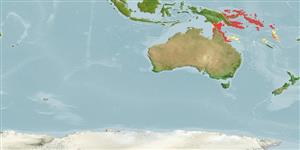分類 / Names
俗名 | 同種異名 | Catalog of Fishes(屬, 種) | ITIS | CoL | WoRMS | Cloffa
Teleostei >
Ovalentaria/misc (Various families in series Ovalentaria)
鱸形目 (Various families in series Ovalentaria) >
Pomacentridae (Damselfishes)
雀鯛科 (Damselfishes) > Pomacentrinae
Etymology: Amphiprion: Greek, amphi = on both sides + Greek, prion, -onos = saw (Ref. 45335).
More on author: Lacepède.
Environment: milieu / climate zone / depth range / distribution range
生態學
海洋 礁區魚類; 非遷移的; 深度上下限 1 - 15 m (Ref. 9710). 熱帶; 6°S - 26°S, 141°E - 155°E (Ref. 55268)
Western Pacific: Queensland and Melanesia including northern Great Barrier Reef, northern New Guinea, New Britain, Solomon Islands and Vanuatu. Not known from New Caledonia and the Fiji Islands, although Fowler (1959) recorded it from the latter area. Often confused with Amphiprion ocellaris.
西太平洋: 昆士蘭省與美拉尼西亞包括大堡礁北方,新幾內亞北部,新不列顛,索羅門群島與萬那度。 已知不來自新加勒多尼亞與斐濟島,雖然 Fowler(1959) 記錄了它從較後者的區域。 時常與 Amphiprion ocellaris 互相混淆。
Length at first maturity / 大小 / 重量 / 年齡
Maturity: Lm ?, range 5 - ? cm
Max length : 11.0 cm TL 雄魚/尚未辨別雌雄; (Ref. 9710)
背棘 (總數) : 9 - 10; 背的軟條 (總數) : 14 - 17; 臀棘: 2; 臀鰭軟條: 11 - 13.
全體橘色的有三條黑色-毗鄰了垂直的白色條紋。 鰭也橘色的有黑邊。 9根棘的背部計數.(參考文獻 48636)
Adults inhabit lagoon and seaward reefs (Ref. 9710). Each group of fish consists of a breeding pair and 0-4 non-breeders. Within each group there is a size-based hierarchy: the female is largest, the male is second largest, and the non-breeders get progressively smaller as the hierarchy is descended. If the female dies, the male changes sex and becomes the breeding female, while the largest non-breeder becomes the breeding male. The maintenance of size differences may avoid conflicts, because subordinates do not become a threat to their dominants (Ref. 47841). Oviparous, distinct pairing during breeding (Ref. 205). Eggs are demersal and adhere to the substrate (Ref. 205). Males guard and aerate the eggs (Ref. 205). Maybe found in shallower depths than A. ocellaris. Associated with the anemones: Heteractis crispa, Heteractis magnifica, and Stichodactyla gigantea (Ref. 5911). This species has been reared in captivity (Ref. 35404, 35413, 35420).
棲息於潟湖與臨海礁石。 (參考文獻 9710) 魚的每個群由一個繁殖對與 0-4個非養育者組成。 在每個群裡面有一個以大小為基礎的階級組織: 母魚大, 雄魚是第二的大, 而且當階級組織是 desceded 的時候,非養育者漸進比較小。 如果母魚死亡, 雄魚改變性別而且成為繁殖母魚, 然而大的非養育者變成繁殖期的雄魚。 因為屬下不變成的威脅,所以大小不同的維護可能避開衝突他們的優勢.(參考文獻 47841) 似乎超過 A. ocellaris 出現在深度較淺的地方。 這種已經被後面在繁殖場。 (參考文獻 35404,35413,35420) 伴隨著卷曲異輻海葵了: 四色海葵 ,Heteractis magnifica, 與 Stichodactyla gigantea.(參考文獻 5911)
Life cycle and mating behavior
成熟度 | 繁殖 | 產卵場 | 卵 | 孕卵數 | 仔魚
Each group of fish consists of a breeding pair and 0-4 non-breeders. Within each group there is a size-based hierarchy: the female is largest, the male is second largest, and the non-breeders get progressively smaller as the hierarchy is desceded. If the female dies, the male changes sex and becomes the breeding female, while the largest non-breeder becomes the breeding male (Ref. 47841). Oviparous, distinct pairing during breeding (Ref. 205). Eggs are demersal and adhere to the substrate (Ref. 205). Males guard and aerate the eggs (Ref. 205). Also Ref. 7471.西太平洋: 昆士蘭省與美拉尼西亞包括大堡礁北方,新幾內亞北部,新不列顛,索羅門群島與萬那度。 已知不來自新加勒多尼亞與斐濟島,雖然 Fowler(1959) 記錄了它從較後者的區域。 時常與 Amphiprion ocellaris 互相混淆。
Allen, G.R., 1991. Damselfishes of the world. Mergus Publishers, Melle, Germany. 271 p. (Ref. 7247)
IUCN 瀕危狀態 (Ref. 130435: Version 2024-1)
無危 (LC) ; Date assessed: 16 November 2010
人類使用
漁業: 沒有興趣; 水族館: 商業性
工具
特別的報告
下載 XML
網路資源
Estimates based on models
Preferred temperature (Ref.
123201): 25.5 - 28.4, mean 27.3 °C (based on 198 cells).
Phylogenetic diversity index (Ref.
82804): PD
50 = 0.5000 [Uniqueness, from 0.5 = low to 2.0 = high].
Bayesian length-weight: a=0.01479 (0.00651 - 0.03363), b=3.00 (2.81 - 3.19), in cm total length, based on LWR estimates for this (Sub)family-body shape (Ref.
93245).
營養階層 (Ref.
69278): 2.7 ±0.3 se; based on size and trophs of closest relatives
回復力 (Ref.
120179): 高度, 族群倍增時間少於 15個月 (Preliminary K or Fecundity.).
Fishing Vulnerability (Ref.
59153): Low vulnerability (10 of 100).
Nutrients (Ref.
124155): Calcium = 123 [67, 201] mg/100g; Iron = 0.844 [0.521, 1.333] mg/100g; Protein = 18.5 [17.4, 19.5] %; Omega3 = 0.134 [0.083, 0.212] g/100g; Selenium = 20.7 [12.1, 37.7] μg/100g; VitaminA = 126 [41, 390] μg/100g; Zinc = 2.28 [1.58, 3.16] mg/100g (wet weight);
